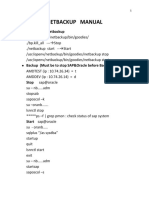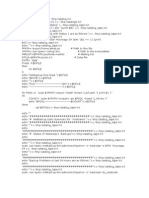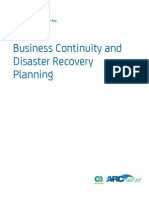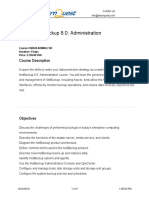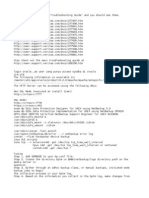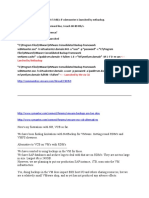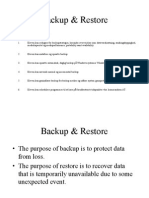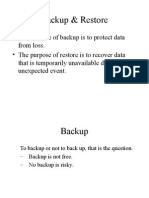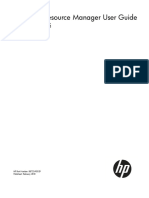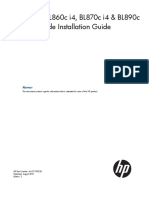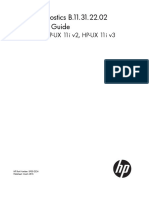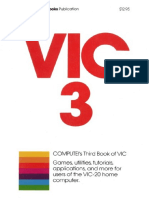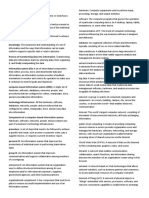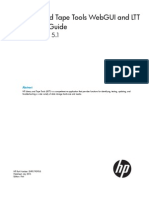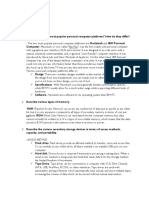Backup and Recovery
Module 4.2
2006 EMC Corporation. All rights reserved.
Backup and Recovery
Upon completion of this module, you will be able to:
Describe best practices for planning Backup and
Recovery.
Describe the common media and types of data that are
part of a Backup and Recovery strategy.
Describe the common Backup and Recovery topologies.
Describe the Backup and Recovery Process.
Describe Management considerations for Backup and
Recovery.
2006 EMC Corporation. All rights reserved. Backup and Recovery - 2
In this module
This module contains the following lessons:
Planning for Backup and Recovery
Backup and Recovery Methods
Backup Architecture Topologies
Managing the Backup Process
2006 EMC Corporation. All rights reserved. Backup and Recovery - 3
Lesson: Planning for Backup and Recovery
Upon completion of this lesson, you be able to:
Define Backup and Recovery.
Describe common reasons for a Backup and Recovery
plan.
Describe the business considerations for Backup and
Recovery.
Define RPO and RTO.
Describe the data considerations for Backup and
Recovery
Describe the planning for Backup and Recovery.
2006 EMC Corporation. All rights reserved. Backup and Recovery - 4
What is a Backup?
Backup is an additional copy of data that can be used for
restore and recovery purposes.
The Backup copy is used when the primary copy is lost
or corrupted.
This Backup copy can be created as a:
Simple copy (there can be one or more copies)
Mirrored copy (the copy is always updated with whatever is written
to the primary copy.)
2006 EMC Corporation. All rights reserved. Backup and Recovery - 5
Backup and Recovery Strategies
Several choices are available to get the data to the backup
media such as:
Copy the data.
Mirror (or snapshot) then copy.
Remote backup.
Copy then duplicate or remote copy.
2006 EMC Corporation. All rights reserved. Backup and Recovery - 6
Its All About Recovery!
Businesses back up their data to enable its recovery in
case of potential loss.
Businesses also back up their data to comply with
regulatory requirements.
Types of backup derivatives:
Disaster Recovery
Archival
Operational
2006 EMC Corporation. All rights reserved. Backup and Recovery - 7
Reasons for a Backup Plan
Hardware Failures
Human Factors
Application Failures
Security Breaches
Disasters
Regulatory and Business Requirements
2006 EMC Corporation. All rights reserved. Backup and Recovery - 8
How does Backup Work?
Client/Server Relationship
Server
Directs Operation
Maintains the Backup Catalog
Client
Gathers Data for Backup (a backup client sends backup data to a
backup server or storage node).
Storage Node
2006 EMC Corporation. All rights reserved. Backup and Recovery - 9
How does Backup Work, continued
Clients
Servers
Backup Clients
Backup Server
& Storage Node
Metadata
Data Set
Catalog
Disk Tape
Storage Backup
2006 EMC Corporation. All rights reserved. Backup and Recovery - 10
Business Considerations
Customer business needs determine:
What are the restore requirements RPO & RTO?
Where and when will the restores occur?
What are the most frequent restore requests?
Which data needs to be backed up?
How frequently should data be backed up?
hourly, daily, weekly, monthly
How long will it take to backup?
How many copies to create?
How long to retain backup copies?
2006 EMC Corporation. All rights reserved. Backup and Recovery - 11
Data Considerations: File Characteristics
Location
Size
Number
2006 EMC Corporation. All rights reserved. Backup and Recovery - 12
Data Considerations: Data Compression
Compressibility depends on the data type, for example:
Application binaries do not compress well.
Text compresses well.
JPEG/ZIP files are already compressed and expand if
compressed again.
2006 EMC Corporation. All rights reserved. Backup and Recovery - 13
Data Considerations: Retention Periods
Operational
Data sets on primary media (disk) up to the point where most restore
requests are satisfied, then moved to secondary storage (tape).
Disaster Recovery
Driven by the organizations disaster recovery policy
Portable media (tapes) sent to an offsite location / vault.
Replicated over to an offsite location (disk).
Backed up directly to the offsite location (disk, tape or emulated tape).
Archiving
Driven by the organizations policy.
Dictated by regulatory requirements.
2006 EMC Corporation. All rights reserved. Backup and Recovery - 14
Lesson: Summary
Topics in this lesson included:
Backup and Recovery definitions and examples.
Common reasons for Backup and Recovery.
The business considerations for Backup and Recovery.
Recovery Point Objectives and Recovery Time
Objectives.
The data considerations for Backup and Recovery
The planning for Backup and Recovery.
2006 EMC Corporation. All rights reserved. Backup and Recovery - 15
Lesson: Backup and Recovery Methods
Upon completion of this lesson, you be able to:
Describe Hot and Cold Backups.
Describe the levels of Backup Granularity.
2006 EMC Corporation. All rights reserved. Backup and Recovery - 16
Database Backup Methods
Hot Backup: production is not interrupted.
Cold Backup: production is interrupted.
Backup Agents manage the backup of different data
types such as:
Structured (such as databases)
Semi-structured (such as email)
Unstructured (file systems)
2006 EMC Corporation. All rights reserved. Backup and Recovery - 17
Backup Granularity and Levels
Full Backup
Cumulative (Differential)
Incremental
Full Cumulative Incremental
2006 EMC Corporation. All rights reserved. Backup and Recovery - 18
Restoring an Incremental Backup
Monday Tuesday Wednesday Thursday
Files 1, 2, 3 File 4 File 3 File 5 Files 1, 2, 3, 4, 5
Full Backup Incremental Incremental Incremental
Production
Key Features
Files that have changed since the last full or incremental backup are
backed up.
Fewest amount of files to be backed up, therefore faster backup and less
storage space.
Longer restore because last full and all subsequent incremental backups
must be applied.
2006 EMC Corporation. All rights reserved. Backup and Recovery - 19
Restoring a Cumulative Backup
Monday Tuesday Wednesday Thursday
Files 1, 2, 3 File 4 Files 4, 5 Files 4, 5, 6 Files 1, 2, 3, 4, 5, 6
Full Backup Cumulative Cumulative Cumulative
Production
Key Features
More files to be backed up, therefore it takes more time to backup
and uses more storage space.
Much faster restore because only the last full and the last cumulative
backup must be applied.
2006 EMC Corporation. All rights reserved. Backup and Recovery - 20
Lesson: Summary
Topics in this lesson included:
Hot and Cold Backups.
The levels of Backup Granularity.
2006 EMC Corporation. All rights reserved. Backup and Recovery - 21
Lesson: Backup Architecture Topologies
Upon completion of this lesson, you be able to:
Describe DAS, LAN, SAN, Mixed topologies.
Describe backup media considerations.
2006 EMC Corporation. All rights reserved. Backup and Recovery - 22
Backup Architecture Topologies
There are 3 basic backup topologies:
Direct Attached Based Backup
LAN Based Backup
SAN Based Backup
These topologies can be integrated, forming a mixed
topology
2006 EMC Corporation. All rights reserved. Backup and Recovery - 23
Direct Attached Based Backups
LAN
Metadata
Data
Catalog
Media
Backup Server Storage Node Backup
Backup Client
2006 EMC Corporation. All rights reserved. Backup and Recovery - 24
LAN Based Backups
Database Server Mail Server
Backup Client Backup Client
Metadata
Data LAN
Data
Metadata
Backup Server
Storage Node
Storage Node
2006 EMC Corporation. All rights reserved. Backup and Recovery - 25
SAN Based Backups (LAN Free)
Mail Server
Storage Node
Backup Client
LAN Data
SAN
Metadata Backup
Device
Data
Backup Server
2006 EMC Corporation. All rights reserved. Backup and Recovery - 26
SAN/LAN Mixed Based Backups
Storage Node
Database Server Mail Server
Backup Client Backup Client
Data
LAN
Data
SAN
Metadata
Backup
Data Device
Backup Server
2006 EMC Corporation. All rights reserved. Backup and Recovery - 27
Backup Media
Tape
Traditional destination for backups
Sequential access
No protection
Disk
Random access
Protected by the storage array (RAID, hot spare, etc)
2006 EMC Corporation. All rights reserved. Backup and Recovery - 28
Multiple Streams on Tape Media
Data from
Stream 1 Data from
Stream 2 Data from
Stream 3
Tape
Multiple streams interleaved to achieve higher
throughput on tape
Keeps the tape streaming, for maximum write performance
Helps prevent tape mechanical failure
Greatly increases time to restore
2006 EMC Corporation. All rights reserved. Backup and Recovery - 29
Backup to Disk
Backup to disk minimizes tape in backup environments
by using disk as the primary destination device
Cost benefits
No processes changes needed
Better service levels
Backup to disk aligns backup strategy to RTO and
RPO
2006 EMC Corporation. All rights reserved. Backup and Recovery - 30
Tape versus Disk Restore Comparison
Disk 24
Backup / Restore Minutes
Tape 108
Backup / Restore Minutes
0 10 20 30 40 50 60 70 80 90 100 110 120
Recovery Time in Minutes*
*Total time from point of failure to return of service to e-mail users
Typical Scenario:
800 users, 75 MB mailbox
60 GB database
Source: EMC Engineering and EMC IT
2006 EMC Corporation. All rights reserved. Backup and Recovery - 31 31
Three Backup / Restore Solutions based on RTO
2 Min.
Local Replica / Restore time
17 Min. 19 Minutes
Clone Log playback
Backup on ATA 24 Min. 17 Min. 41 Minutes
Backup on tape 108 Min. 17 Min. 125 Minutes
0 10 20 30 40 50 60 70 80 90 100 110 120 130
Recovery Time in Minutes*
*Total time from point of failure to return of service to e-mail users
Typical Scenario: Time of last image dictates
800 users, 75 MB mailbox the log playback time
60 GB DB restore time Larger data sets extend the
500 MB logs log playback recovery time (ATA and tape)
2006 EMC Corporation. All rights reserved. Backup and Recovery - 32
Traditional Backup, Recovery and Archive Approach
Production environment grows
Requires constant tuning and data placement to
maintain performance
Production Need to add more tier-1 storage
Backup environment grows
Backup windows get longer and jobs do not complete
Backup Restores take longer
Process Requires more tape drives and silos to keep up with
service levels
Archive environment grows
Impact flexibility to retrieve content when requested
Archive
Process Requires more media, adding management cost
No investment protection for long term retention
requirements
2006 EMC Corporation. All rights reserved. Backup and Recovery - 33
Differences Between Backup / Recovery & Archive
Backup / Recovery Archive
A secondary copy of information Primary copy of information
Used for recovery operations Available for information retrieval
Improves availability by enabling Adds operational efficiencies by
application to be restored to a moving fixed / unstructured content
specific point in time out of operational environment
Typically short-term (weeks or Typically long-term (months, years,
months) or decades)
Data typically maintained for
Data typically overwritten on
analysis, value generation, or
periodic basis (e.g., monthly)
compliance
Useful for compliance and should
Not for regulatory compliance
take into account information-
though some are forced to use
retention policy
2006 EMC Corporation. All rights reserved. Backup and Recovery - 34
New Architecture for Backup, Recovery & Archive
Backup 3 2 Archive
Process Production Process
4 4
Understand the environment
Actively archive valuable information to tiered
storage
Back up active production information to disk
Retrieve from archive or recover from backup
2006 EMC Corporation. All rights reserved. Backup and Recovery - 35
Lesson: Summary
Topics in this lesson included:
The DAS, LAN, SAN, and Mixed topologies.
Backup media considerations.
2006 EMC Corporation. All rights reserved. Backup and Recovery - 36
Lesson: Managing the Backup Process
Upon completion of this lesson, you be able to:
Describe features and functions of common
Backup/Recovery applications.
Describe the Backup/Recovery process management
considerations.
Describe the importance of the information found in
Backup Reports and in the Backup Catalog.
2006 EMC Corporation. All rights reserved. Backup and Recovery - 37
How a Typical Backup Application Works
Backup clients are grouped and associated with a Backup
schedule that determines when and which backup type will
occur.
Groups are associated with Pools, which determine which
backup media will be used.
Each backup media has a unique label.
Information about the backup is written to the Backup Catalog
during and after it completes. The Catalog shows:
when the Backup was performed, and
which media was used (label).
Errors and other information is also written to a log.
2006 EMC Corporation. All rights reserved. Backup and Recovery - 38
Backup Application User Interfaces
There are typically two types of user interfaces:
Command Line Interface CLI
Graphical User Interfaces GUI
2006 EMC Corporation. All rights reserved. Backup and Recovery - 39
Managing the Backup and Restore Process
Running the B/R Application: Backup
The backup administrator configures it to be started, most (if not all)
of the times, automatically
Most backup products offer the ability for the backup client to initiate
their own backup (usually disabled)
Running the B/R Application: Restore
There is usually a separate GUI to manage the restore process
Information is pulled from the backup catalog when the user is
selecting the files to be restored
Once the selection is finished, the backup server starts reading from
the required backup media, and the files are sent to the backup
client
2006 EMC Corporation. All rights reserved. Backup and Recovery - 40
Backup Reports
Backup products also offer reporting features.
These features rely on the backup catalog and log files.
Reports are meant to be easy to read and provide
important information such as:
Amount of data backed up
Number of completed backups
Number of incomplete backups (failed)
Types of errors that may have occurred
Additional reports may be available, depending on the
backup software product used.
2006 EMC Corporation. All rights reserved. Backup and Recovery - 41
Importance of the Backup Catalog
As you can see, backup operations strongly rely on the
backup catalog
If the catalog is lost, the backup software alone has no
means to determine where to find a specific file backed
up two months ago, for example
It can be reconstructed, but this usually means that all of
the backup media (i.e. tapes) have to be read
Its a good practice to protect the catalog
By replicating the file system where it resides to a remote location
By backing it up
Some backup products have built-in mechanisms to
protect their catalog (such as automatic backup)
2006 EMC Corporation. All rights reserved. Backup and Recovery - 42
Lesson: Summary
Topics in this lesson included:
The features and functions of common Backup/Recovery
applications.
The Backup/Recovery process management
considerations.
The importance of the information found in Backup
Reports and in the Backup Catalog.
2006 EMC Corporation. All rights reserved. Backup and Recovery - 43
Module Summary
Key points covered in this module:
The best practices for planning Backup and Recovery.
The common media and types of data that are part of a
Backup and Recovery strategy.
The common Backup and Recovery topologies.
The Backup and Recovery Process.
Management considerations for Backup and Recovery.
2006 EMC Corporation. All rights reserved. Backup and Recovery - 44
Check Your Knowledge
What are three reasons for doing a Backup plan?
What are the three topologies that support creating a
Backup set?
What are the advantages and disadvantages of using
tape as the Backup media?
What are the three levels of granularity found in
Backups?
2006 EMC Corporation. All rights reserved. Backup and Recovery - 45
Apply Your Knowledge
Upon completion of this topic, you will be able to:
Describe EMCs product implementation of a Backup
and Recovery solution.
2006 EMC Corporation. All rights reserved. Backup and Recovery - 46
EMC NetWorker
Tiered Protection and Recovery Management
Remove risk
Faster and more consistent data
backup
Backup Advanced
Basic
Improve reliability Tape backup
to disk
Disk-backup
backup
Snapshot
and recovery
Keep recovery copies fresh and option management
reduce process errors
SERVICE-LEVEL REQUIREMENTS
Lower total cost of Low High
ownership
Centralization and ease of use
2006 EMC Corporation. All rights reserved. Backup and Recovery - 47
NetWorker Backup and Recovery
Solution Features
Enterprise protection
Basic Architecture Critical applications
Heterogeneous Heterogeneous platforms and
clients storage
Key
applications Scalable architecture
256-bit AES encryption and secure
authentication
LAN
Centralized management
Backup
server Graphical user interface
NAS Customizable reporting
Storage
(NDMP)
SAN
Node Wizard-driven configuration
Performance
Data multiplexing
Tape
library Advanced indexing
Efficient media management
2006 EMC Corporation. All rights reserved. Backup and Recovery - 48
Critical Application and Database Protection
Backup without Application Backup with NetWorker
Modules Application Modules
Offline (Cold)
Shut down Application
application Application
NetWorker MODULE
24x7 OPERATIONS
Back up DOWNTIME
application SAVE
Restart
application Application
Integration with application APIs
for backup and recovery
2006 EMC Corporation. All rights reserved. Backup and Recovery - 49
Media-Management Advantages
Open Tape Format
Datastream multiplexing
Self-contained indexing
Cross-platform format
UNIX Windows Linux
Minimize impact of tape corruption
Dynamic drive sharing
Cross-platform tape-drive sharing
On-demand device usage
NetWorker NetWorker
Reduce hardware total cost of UNIX/Linux Windows
ownership
2006 EMC Corporation. All rights reserved. Backup and Recovery - 50
NetWorker DiskBackup Option
High performance
Backup-to-Disk Architecture
Simultaneous-access operations
Heterogeneous No penalty on restore versus tape
clients
Key
applications Policy-based migration of data
from disk to tape
Automated staging and cloning
LAN
Up to 50% faster
Backup Clone backups jobs as they
server complete
NAS Storage Reduce wear and tear on tape
Node drives and cartridges
SAN
Superior capability
Disk- Operational backup and recovery
Tape backup for all clients, including NAS with
library target
NDMP
Direct file access for fast recovery
2006 EMC Corporation. All rights reserved. Backup and Recovery - 51
Advanced Backup - Snapshots and CDP
Integration of backup with snapshots, full-volume mirrors,
and Continuous Data Protection (CDP) Production
server
Instant restore
Off-host backups
Production
Achieve stringent recovery-time objectives (RTOs), information
recovery-point objectives (RPOs)
Recover
It is expected that snapshot Backup
technology for data protection will
surpass backup to tape as the trend Snapshot Backup snap
in data protection as organizations 5:00 p.m. 10:00 p.m.
Snapshot
continue to focus on recovery times 11:00 a.m. Backup
server
2006 EMC Corporation. All rights reserved. Backup and Recovery - 52
NetWorker PowerSnap Module
Policy-based management
Advanced Backup
Administer snapshots in
Heterogeneous NetWorker
clients
Key Schedule, create, retain, and
applications delete snapshots by policy
Third-party integration
LAN Leverage third-party replication
technology
Backup
server Array-based (Symmetrix DMX,
CLARiiON CX, etc.)
NAS Storage Software-based (RecoverPoint)
Node
SAN
Application recovery
CLARiiON Integration with Application
Tape with Modules to ensure consistent
library SnapView state
Exchange / SQL / Oracle / SAP
2006 EMC Corporation. All rights reserved. Backup and Recovery - 53
NetWorker SnapImage Module
Advanced Backup Block-level backups
Host-based snapshot
Targeted at high-density file
systems
Single-file restore
Sparse backups
High performance
Significant backup-and-restore
performance impactup to 10
times faster
Drive tape at rated speeds
10,000,000+ files Optional network-accelerated
1,000,000+ directories serverless backup with Cisco
intelligent switch
2006 EMC Corporation. All rights reserved. Backup and Recovery - 54
Solution Example: Major Telecom Company
Enterprise-Information Protection
Business Challenge: Solution:
NetWorker PowerSnap with
Complex application Symmetrix and TimeFinder/Snap
environment Server-free backup
No backup window NetWorker DiskBackup Option with
CLARiiON with ATA disks
Recovery-time objective: Rapid primary-site protection
Restore 24 TB in two NetWorker and SRDF/S
hours Disaster recovery
Offsite protection
Disaster-Recovery Site Production Site
NetWorker
Disaster- Storage Node
recovery host Application Storage Node Value Proposition
host PowerSnap
Tape Zero backup window for
library SAN
SAN Tape applications
library Eliminated data-loss risk
SRDF/S
Reduced management
Symmetrix Symmetrix CLARiiON
DMX DMX CX overhead
2006 EMC Corporation. All rights reserved. Backup and Recovery - 55 55















